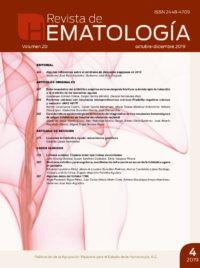Características epidemiológicas al momento del diagnóstico de tres neoplasias hematológicas de origen linfoide en un hospital de referencia nacional
Rev Hematol Mex. 2019 October-December;20(4):262-272. https://doi.org/10.24245/rhematol.v20i4.3515
María de Jesús Nambo-Lucio,1 Neri Natividad Muñoz,1 Sergio Adrián Cleto-Gutiérrez,1 José Alberto Regalado-Ramos,2 Miguel Ángel Herrera-Rojas2
1 Siglo XXI National Medical Center Cancer Hospital, Hematology and Bone Marrow Transplant Service, IMSS, Mexico City.
2 Janssen-Cilag SA de CV.
Abstract
OBJECTIVE: To identify the demographic, clinical characteristics and the most frequently prescribed treatments of patients with diagnosis of non-Hodgkin mantle cell lymphoma (MCL), chronic lymphocytic leukemia (CLL) or multiple myeloma (MM) who received care at a Mexican hospital.
MATERIAL AND METHOD: A retrospective study was conducted, analyzing the clinical records of patients with diagnosis of MCL, CLL, or MM who received care at the Siglo XXI National Medical Center Cancer Hospital Hematology Service from June 2008 to October 2016.
RESULTS: 399 patients were included, 214 (54%) men, with median age of 60 years (38 to 88). The distribution was 31 (8%) patients with MCL, 21 (5%) with CLL, and 347 (87%) with MM. The most common initial clinical manifestation was weight loss in MCL and CLL, and lumbar pain in MM. The median time for a patient to see a doctor was greater in patients with MM than in MCL and CLL (7.2 vs 5 and 6 months). The common denominator in the three neoplasms was that most of patients were in an advanced stage of the disease at the time of diagnosis.
CONCLUSION: Most of demographic characteristics of patients included were similar to those described in the literature; however, the age of patients with myeloma was lower, the time to diagnosis was greater and stage of disease at diagnosis was higher than expected.
KEYWORDS: Non-Hodgkin mantle cell lymphoma; chronic lymphocytic leukemia; Multiple myeloma.
Resumen
OBJETIVO: Identificar las características demográficas, clínicas y los tratamientos más prescritos de los pacientes con diagnóstico de linfoma no Hodgkin de células del manto, leucemia linfocítica crónica o mieloma múltiple.
MATERIAL Y MÉTODO: Estudio retrospectivo que analizó las características clínicas de pacientes con diagnóstico de linfoma no Hodgkin de células del manto, leucemia linfocítica crónica o mieloma múltiple que recibieron atención en el Servicio de Hematología del Hospital Centro Médico Nacional Siglo XXI de junio de 2008 a octubre de 2016.
RESULTADOS: Se incluyeron 399 pacientes, 214 (54%) hombres, con mediana de edad de 60 años (38 a 88). La distribución fue: 31 (8%) pacientes con linfoma no Hodgkin de células del manto, 21 (5%) con leucemia linfocítica crónica y 347 (87%) con mieloma múltiple. La manifestación clínica inicial más común fue pérdida de peso en linfoma no Hodgkin de células del manto y leucemia linfocítica crónica, y el dolor lumbar en mieloma múltiple. El tiempo promedio para que un paciente acudiera con el médico fue mayor en pacientes con mieloma múltiple que en linfoma no Hodgkin de células del manto y leucemia linfocítica crónica (7.2 vs 5 y 6 meses). La mayoría de los pacientes estaban en una etapa avanzada de la enfermedad al momento del diagnóstico de las tres neoplasias.
CONCLUSIÓN: La mayor parte de las características demográficas de los pacientes fueron similares a las descritas en la bibliografía; sin embargo, la edad de los pacientes con mieloma fue menor, el tiempo para el diagnóstico fue mayor y la etapa de la enfermedad al momento del diagnóstico fue mayor de lo esperado.
PALABRAS CLAVE: Linfoma no Hodgkin de células del manto; leucemia linfocítica crónica; mieloma múltiple.

